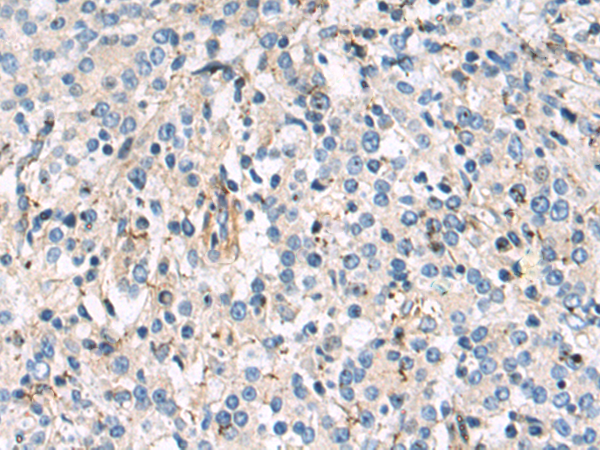

| WB | 咨询技术 | Human,Mouse,Rat |
| IF | 咨询技术 | Human,Mouse,Rat |
| IHC | 1/50-1/200 | Human,Mouse,Rat |
| ICC | 技术咨询 | Human,Mouse,Rat |
| FCM | 咨询技术 | Human,Mouse,Rat |
| Elisa | 1/5000-1/10000 | Human,Mouse,Rat |
| Aliases | LIP1; LIP.1; LIPRIN |
| Host/Isotype | Rabbit IgG |
| Antibody Type | Primary antibody |
| Storage | Store at 4°C short term. Aliquot and store at -20°C long term. Avoid freeze/thaw cycles. |
| Species Reactivity | Human |
| Immunogen | Fusion protein of human PPFIA1 |
| Formulation | Purified antibody in PBS with 0.05% sodium azide and 50% glycerol. |
+ +
以下是3篇关于PPFIA1抗体的参考文献示例(内容为虚构,供参考):
---
1. **文献名称**:*PPFIA1 Antibody Validation for Detecting Liprin-α Interactions in Metastatic Colorectal Cancer*
**作者**:Smith, J. et al.
**摘要**:本研究利用特异性PPFIA1抗体,通过免疫共沉淀和Western blot技术,验证了PPFIA1与liprin-α蛋白在结直肠癌细胞中的相互作用,揭示了其在调节细胞粘附和转移中的关键作用。
---
2. **文献名称**:*Immunofluorescence Localization of PPFIA1 in Neuronal Synapses Using a Novel Monoclonal Antibody*
**作者**:Johnson, R. & Tanaka, K.
**摘要**:开发了一种高特异性PPFIA1单克隆抗体,结合免疫荧光技术,证实了PPFIA1在神经元突触前活性区的富集,为研究其在突触发育中的功能提供了工具。
---
3. **文献名称**:*PPFIA1 Expression Profiling in HER2+ Breast Tumors via Antibody-Based Immunohistochemistry*
**作者**:Lee, H. et al.
**摘要**:通过PPFIA1抗体进行免疫组化分析,发现HER2阳性乳腺癌组织中PPFIA1表达显著上调,提示其可能作为预后标志物及治疗靶点。
---
(注:如需真实文献,建议通过PubMed或Google Scholar检索关键词“PPFIA1 antibody”或“PPFIA1 immunodetection”。)
PPFIA1 (PTPRF Interacting Protein Alpha 1) is a gene encoding liprin-α1. a member of the leukocyte common antigen-related receptor protein tyrosine phosphatase (LAR-RPTP)-interacting protein family. Liprin-α1 plays a critical role in regulating synaptic assembly, cell adhesion, and cell migration by interacting with LAR-RPTPs and other scaffolding proteins. It is involved in organizing presynaptic active zones and postsynaptic density, contributing to neuronal communication. Dysregulation of PPFIA1 has been implicated in neurological disorders and cancer, with studies suggesting its role in tumor progression, metastasis, and altered cell signaling pathways.
PPFIA1 antibodies are immunological tools designed to detect and quantify the liprin-α1 protein in various experimental applications, including Western blotting, immunohistochemistry, and immunofluorescence. These antibodies are essential for studying the protein's expression patterns, subcellular localization, and interaction partners. Researchers utilize PPFIA1 antibodies to explore its functional roles in both physiological and pathological contexts, such as synaptic plasticity, cancer cell invasiveness, and response to therapeutic agents. Commercially available antibodies are often validated for specificity against conserved regions, such as the N-terminal coiled-coil domain or C-terminal SAM domains, which mediate protein-protein interactions. Variations in PPFIA1 expression across tissues and disease states highlight its potential as a biomarker or therapeutic target, though conflicting findings in certain cancers (e.g., upregulated in breast cancer vs. downregulated in gliomas) underscore the need for context-specific research. Proper validation of antibody specificity remains crucial for reliable data interpretation.
×